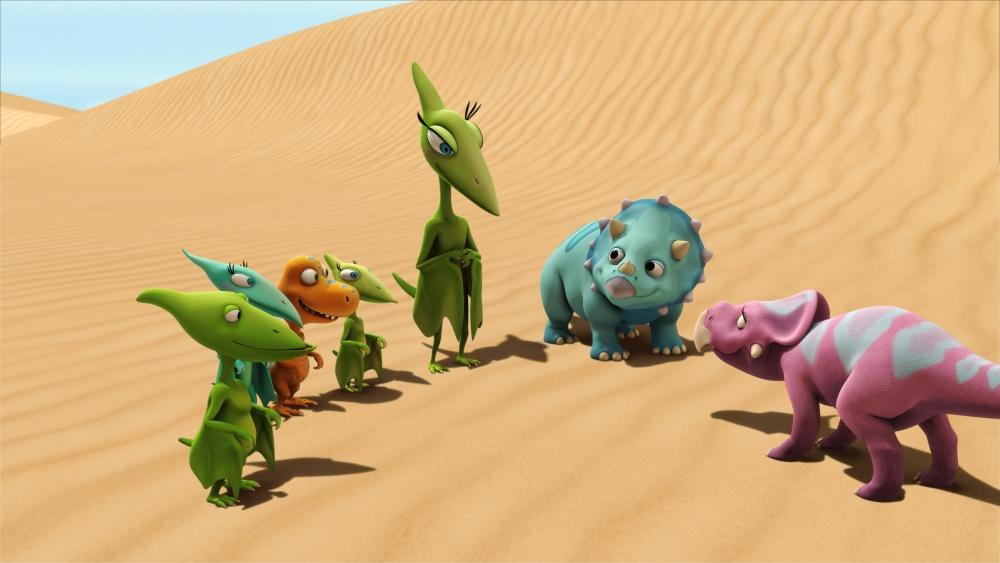
Section Branding
Header Content
Dinosaur Train - Earthquake!
Primary Content

The first episode of “Dinosaur Train – Weather Week” is titled “Episode 207: The Earthquake/Nursery Car”. In this episode, the Pteranodon Family meets Penelope Protoceratops, who lives in an area that gets a lot of earthquakes. On the Train, Mr. Conductor explains what causes an earthquake, and how to stay safe when the Earth begins to vibrate.
In modern times, earthquakes often occur in areas of the world located near large faults, such as California, Hawaii, and Japan. Recently, though, earthquakes have been occurring far away from these large faults. On August 23, 2011, an earthquake struck 5 miles southwest of Mineral, Virginia, impacting many areas of Virginia, including the nation’s capitol. The earthquake reached a 5.8 magnitude on the Richter scale (Source: USGS).
Here in Georgia, an earthquake occurred in April 29, 2003, about 30 miles northwest of Rome; it reached a 4.6 magnitude on the Richter scale (Source: USGS). According to the United States Geological Survey (USGS), Georgia’s largest earthquake occurred on March 5, 1916, about 30 miles southeast of Atlanta. The quake reached a 4.5 magnitude on the Richter scale, and it was felt as far northeast as Raleigh, North Carolina, and as west as Alabama and Tennessee (Source: USGS).
Dr. Leland Timothy Long, a geologist and professor for Georgia Tech, has observed that there are two major “earthquake zones” within the state of Georgia: one located near the Tennessee border, and the other in central Georgia (you can read more about Professor Long’s report here). Therefore, it is important to be prepared for earthquakes here in the Peach State, even though they are infrequent for our area.
Unfortunately, earthquakes cannot be predicted at this time – the best scientists can do is monitor the earth’s seismic activity for indications of strong vibrations. Once the earth begins shakin’ and quakin’, it is important to know what to do in order to stay safe. The Dinosaur gang demonstrated a couple of steps they took when they experienced an earthquake:
Just like Mrs. Pteranodon, I am proud of the Dinosaur kids, too! They performed the following safety tips perfectly during they earthquake:
1.)Stay calm, and don’t panic
2.)Stay out in the open
3.)Look out for falling objects
Later on, the Dinosaur Family experienced an aftershock on the Dinosaur Train. In this clip, Mr. Conductor explained what exactly is an aftershock:
It is a good idea to keep these safety tips in mind during an earthquake, since aftershocks are possible after the main, larger quake.
I hope you are excited to watch this episode of the Dinosaur Train! Episode #207 will air on GPB on Tuesday, February 7th at 8:30am and again at 1:00pm. Let me know what you think about this episode, Nature Trackers! Also, tell me your earthquake experiences! Have you ever experienced the earth shaking? How did you stay safe! I’d love to hear your stories!
Additional Resources You May Like
List of Dinosaur Train - Weather Week Episodes
The United States Geological Survey Earthquake Hazards Program
The Geophysics Department of the School of Earth and Atmospheric Sciences at the Georgia Institute of Technology
Dr. Leland Timothy Long, Professor and Geophysicist at the School of Earth and Atmospheric Sciences at the Georgia Institute of Technology
Dr. Scott the Paleontologist's Blog
Dinosaur Train Activity Coloring Sheet
Dinosaur Train on PBSKids.org





